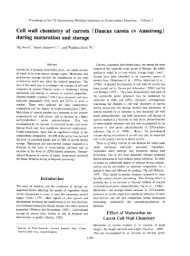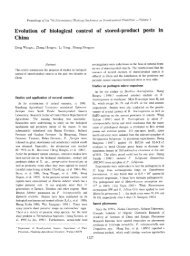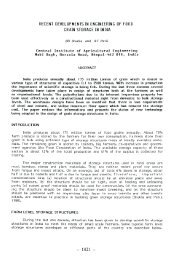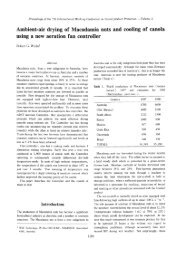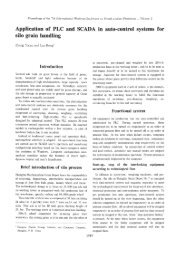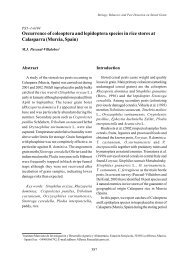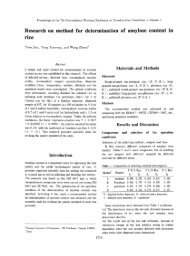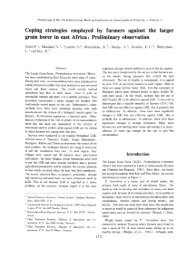72-87 - SPIRU Index Page
72-87 - SPIRU Index Page
72-87 - SPIRU Index Page
Create successful ePaper yourself
Turn your PDF publications into a flip-book with our unique Google optimized e-Paper software.
Proceedmgs of the 7th Internaiumol WOIklllg Conference on Stored-product Protection. - Volume 1<br />
agnculture IS one of the mam actrvrties (FAO, 1986 16,<br />
Ben Yahmed, 1993), IS a mam area of cowpea production<br />
(FAOSTAT Internet database, Ben Yahmed, 1993, Nwokolo<br />
& Ilechukwu, 1996) Cowpea (Vigna unquiculata Walp )<br />
IS an Important source of protem for low income famihes<br />
(Nwokolo , 1996, Van Alebeek, 1996) Cowpea, hke<br />
sorghum, millet and maize, ISstored dunng the dry season<br />
In rural areas, cowpea IS normally stored on-farm m<br />
traditional granaries, which are made of natural matenals<br />
such as wood, straw, and clay (Sagnia & Schutte, 1992,<br />
Kone, 1993) Cowpeas are often stored as whole-pods, and<br />
only when needed for consumption or for sale, they are<br />
threshed and stored as grams m smaller contamers (e g ,<br />
clay Jars) Typically, a subsistence farmer stores several<br />
hundred kilograms of cowpeas (Sagrna & Schute, 1992)<br />
Cowpeas are not only stored for home consumption but also<br />
for the market, as the pnce of cowpea mcreases towards the<br />
end of the storage season (Caswell, 1974, Sagma &<br />
Schutte, 1992)<br />
Unfortunately, stored cowpea ISoften heavily attacked by<br />
bruchids, of which Collosobruchus maculatus Fab<br />
(Coleoptera Bruchidae) ISthe most Important one (Jackal &<br />
Daoust, 1986, Singh et al ,1990) The bruchid mfestation<br />
starts m the field, where adult females lay smgle eggs on<br />
npenmg pods Larvae that emerge from these eggs<br />
penetrate the seeds, m which they develop and pupate The<br />
adult emerges through an emergence hole m the bean The<br />
total development time IS approximately three weeks at<br />
32°C Adult females live for about a week, dunng which<br />
they may lay some 100 eggs Populations of C maculaius<br />
can grow rapidly m stored cowpea After several months of<br />
storage, the stock may be totally destroyed due to the larval<br />
feedmg<br />
The nutritional value and the quality of stored beans<br />
declme as a result of bruchid mfestation (Modgil & Mehta,<br />
1994, 1996) Although It IS drfficul t to determme exact<br />
losses (Boxall , 1991), quantitative losses are also severe<br />
The loss to bruchids m northern Nlgena m terms of weight<br />
has been estimated at 3 5 - 4% per year (Caswell, 1981)<br />
This corresponds to approximately 20 - 30% of the beans<br />
bemg mfested Weight losses m stored beans m Ghana after<br />
five months of storage were as high as 20 or 45%,<br />
dependmg on whether the beans were stored unthreshed or<br />
shelled, respectively (Adams, 1977, Schulten, 1982)<br />
Control methods<br />
A large vanety of control methods agamst bruchlds m<br />
stored cowpea IS known (Van HUls, 1991, Sagma &<br />
Schutte, 1992, Llenard & Seck, 1994) They are aimed at<br />
either preventmg bruchld mfestatlOn, ehmmatmg or<br />
mmlmlzmg bruchld populations, or a combmatlon of these<br />
effects. The control methods can be roughly dlVlded mto<br />
three categones traditional methods, chemical methods and<br />
73<br />
alternative methods<br />
Traditional methods compnse among others the use of<br />
mert matenals such as sand and wood-ash, and the use of<br />
plant matenals with insecticidal or msect-repellant action<br />
(Javaid & Ramatlakapela, 1995, Apuuh & Villet, 1996,<br />
Ofuya, 1986) Although these methods are often effective,<br />
they are generally labonous and not suitable for large<br />
quantities (e g Taylor, 1975, Compton et al , 1993)<br />
Some methods require a lot of labour when labour demand IS<br />
already high because of the harvest In addition, some<br />
'natural msecticides ' may have chronic negative effects on<br />
human health (Schulten, 1991, Compton et al , 1993)<br />
Chemical control methods equally have several<br />
disadvantages Some pesticrdes do not kill all the larvae and<br />
pupae mside the seeds, wlule they do kill the natural<br />
enemies of the bruchids, which are often more sensitrve to<br />
msecncides (Caswell, 1973, Hames, 1984, Brower et al ,<br />
1996) In addition, pesticides are expensive for subsistence<br />
farmers, and not always available (Lienard & Seck, 1994)<br />
Moreover, farmers are generally not tramed m the use of<br />
pesticides, this results m a low efficacy of their use and an<br />
mcreased health nsk (Schul ten, 1991, Dmham, 1993,<br />
Compton et al , 1993, Schwab et al , 1995, Udoh, 1998)<br />
Alternative methods of control, such as storage of beans<br />
m hermetically closed plastic bags or 011 drums, have shown<br />
prormsmg results (Caswell, 1974, Lienard & Seck, 1994)<br />
Hermetically closed storage suffocates msects within a<br />
relatively short time However, to most Sahehan farmers,<br />
empty 011 drums or a sufficient number of strong plastic bags<br />
are as yet not available or too expensive (S Sagrua, and A<br />
Adandonon, personal commumcations, C Stolk, personal<br />
observation, Gahukar, 1994) Another disadvantage of<br />
plastic bags ISthat they have to be stored m such a way that<br />
they cannot be damaged by e g rodents, as even a small<br />
hole m the bag WIll nulhfy the suffocatmg effect ThIS IS<br />
probably hard to achieve Even the bruchids themselves may<br />
sometimes perforate plastic bags (Lienard & Seck, 1994) It<br />
may also prove dIffIcult to prevent re-mfestatlon If the bags<br />
are opened frequently for the purpose of sellmg beans<br />
For many farmers no adequate method of control of<br />
bruchld pests m cowpea IS therefore avatlable What IS<br />
needed IS a sustamable method of control that IS (1)<br />
effective, (2) practically and economIcally feasIble, (3)<br />
environmentally safe, and (4) flexible Wlthm a changmg<br />
SOCialand agncultural environment BIOlogicalcontrol of<br />
bruchlds may meet all these reqUIrements<br />
Biological control<br />
The most Important natural enerntes of bruchlds of cowpea<br />
are parasltOlds Larval parasltOlds (Dtnarmus basalzs and<br />
EupelrH/8 spp ) and egg-parasltOlds (Uscana spp ) have<br />
been proposed as candidates for biological control of bruchlds<br />
m tropical storage (Monge & HUlgnard, 1991) We




